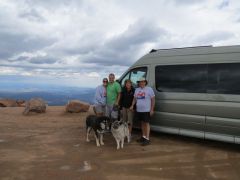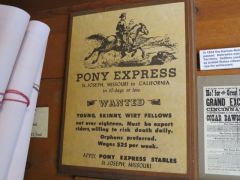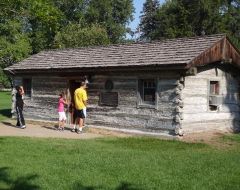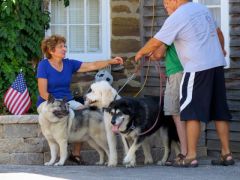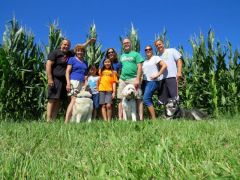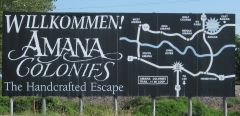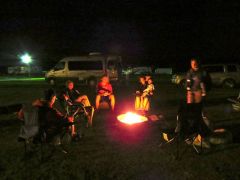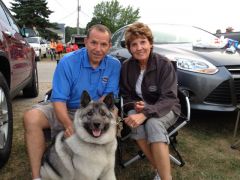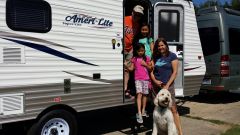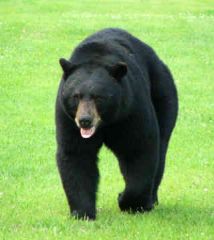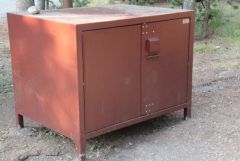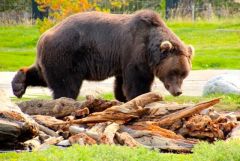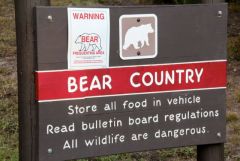-
Content Count
669 -
Joined
-
Last visited
-
Days Won
17
Content Type
Profiles
Forums
Blogs
Gallery
Everything posted by Roadtrekingmike
-
From the album: Pikes Peak, Garden of the Gods and Cheyenne Mountain State P
The Pikes Peak summit. Aimee, Jeff, Jennifer, Mike and our dogs Sequoia and Tai. It was 48 degrees up here at 14,150 feet, compared to the 95 down below. -
It was a day of superlatives as our Roadtrek eTrek literally took us to the heights of RVing – climbing Pikes Peak. Making it even better because it was our wedding anniversary and we were spending it with family in one of the continent’s most beautiful regions. Pikes Peak surely is the most accessible big mountain on the continent, with a first rate road all the way up, despite some hairpin curves with little or no shoulder or guardrails. The only issue we had was on the descent, where at the mandatory brake check around 11,000 feet ours measured 600 degrees. We used low gears to help in slowing the vehicle on the drive down but the eTrek is a heavy vehicle and we needed to pull off and let it rest for a half hour. So did lots of others in cars. I used the downtime to take Tai for a walk and he chased up a couple of mule deer. He thought it great fun and had a sparkle in his big brown Elkhound eyes that lasted the rest of the day. The top of Pikes Peak offers dramatic, craggy windswept views, though we all felt a tinge of dizziness and queasiness, a touch of altitude sickness. Tai loved it at the summit, as did son Jeff’s dog, Sequoia. The temperature up top was 48 degrees. Down below, it was in the nineties. Pikes Peak is rich in history and was the symbol of the 1859 Gold Rush to Colorado with the slogan, “Pikes Peak or Bust.” Today, where pioneers and native Americans used to walk, a 19-mile long highway makes its way to the top, carrying half a million visitors each year. It’s a beautiful drive through alpine forests, mountain reservoirs, and rugged rockface beyond the timberline. Wendy, Dan and the girls didn’t make it to the summit. Wendy felt ill about the 8,000 foot level and they instead hung around at lower altitudes, hiking and taking photos. Off the mountain, we all rendezvoused and visited the spectacular 300-foot tall red rock formations at Garden of the Gods. Several large male mule deer posed for my new telephoto lens. We never would have spotted them had not Tai, his nose already tuned into deer scent from our adventure on the mountain, caught a whiff of them atop a hill at the base of one of the large red formations. We couldn’t figure out why he was so tugging at his leash until someone looked up and shouted “deer.” Our base camp for this part of the trip was the pristine Cheyenne Mountain State Park, located just south of Colorado Springs on the eastern slope of Cheyenne Mountain. The park is clean and new, opened in October 2006 and comprising 1,680 acres. Out our west window is the mountain itself. Out our east windows is a stunning overlook of the plains of Colorado and, at night, the sparkling lights of Colorado Springs. Literally under us is an amazing military complex, a fortress designed during the height of the cold war to withstand a 30 megaton nuclear hit and allow heads of government from the President on down to live in comfort and run the affairs of the country during an emergency. Today, it remains a very active worksite and houses elements of the U.S. Strategic Command, Air Force Space Command, the Defense Intelligence Agency, the National Security Agency, the Missile Defense Agency and the Federal Aviation Authority, among others. That’s hard to tell in our camping spots here. But we know we are near a military installation. At 10 PM the last two nights, we heard a bugler sound taps, its clear, plaintive sound echoing up from the green-roofed military buildings down in the foothills. This morning, we heard reverie as the sky turned pink. And we’ve seen helicopters doing flight training several times, as well. The park is one of the nicest we’ve stayed in anywhere. There are 20 miles of hiking trails, though dogs are not permitted because of wildlife. There are black bears, cougars, coyotes and other critters. The prairie rattlesnake frequents the rocky areas. And a tent full of four young girls near us who are here for a weekend marathon had a scorpion crawl in. We’re about 6,500 feet high at our campsites. Days have been in the nineties, with low humidity. Nights delightfully cool to the low sixties. Wednesday morning we pack up once again as the Great Roadtreking Family Vacation of 2014 continues and we head off to the Four Corners region and Mesa Verde. As I type this lateTuesday night, Jen and I are tucked into the eTrek and the rest of their family aleep in their RVs – Jeff and Aimee and Sequoia in a borrowed Roadtrek SS generously provided by some Roadtrek friends; Wendy, Dan, our granddaughters and their dog, Charley, in the Amerilite travel trailer we just bought from American RV in Grand Rapids and are towing with our Roadtrek eTrek. We wish we had another day or so here. There’s lots more to see in this area. I better be careful what I wish for. Wendy and Dan, following our RVs in our car, report that it’s been making a funny but intermittent squealing noise. I took it for a short test drive but didn’t hear a thing out of the ordinary. I pronounced it just fine. But Jennifer says my hearing isn’t as keen as it should be. So we’re debating whether we should have the car looked at before we continue on.
-
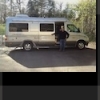
Hard driving, Hells Angels and lots of pit stops
Roadtrekingmike added images to a gallery album in Members Gallery
-
From the album: Hard driving, Hells Angels and lots of pit stops
Pony Express flyer: WANTED. -
From the album: Hard driving, Hells Angels and lots of pit stops
Hua Hua and Rachel check out the sod house. -
From the album: Hard driving, Hells Angels and lots of pit stops
Historic photo of sod house from the late 1800s -
From the album: Hard driving, Hells Angels and lots of pit stops
Pony Express Station in Gothenberg, Nebraska. -
From the album: Hard driving, Hells Angels and lots of pit stops
Juggling the dogs -
From the album: Hard driving, Hells Angels and lots of pit stops
Corn in Iowa sure is tall. -

Hard driving, Hells Angels and lots of pit stops
Roadtrekingmike posted a blog entry in Roadtreking Blog
Now I know how Class A motorhome drivers live. They spend lots of time checking their mirrors, looking for places to park that are big enough to handle their length and…. visiting gas stations. As we are towing a 21-foot travel trailer behind our Roadtrek on a family caravan vacation trip to the Rockies, I’ve found towing very easy and parking not so bad as long as I don’t try pulling in to fast-food places with my 30-foot-plus length. Truthfully, I’ve quickly gotten used to towing and with 1,000-pus miles under my belt as we pulled into Gothenberg, Nebraska, last night, the only complaint I have is what towing a trailer has done to my fuel consumption. Where before my 2012 Roadtrek eTrek averaged 17-18 mpg, towing the 2,780 extra pounds in the trailer has dropped it to 11-12 mpg. Still, it’s well worth it to be all together as a family. This is now my third trip west along I-80 and I have forgotten how much corn they grow our here in the prairie. And how tall it is, easily eight feet in most fields. The biggest challenge we’ve had so far is group sightseeing with three big dogs. Someone always has to stay outside or behind to tend to the dogs. The biggest excitement yesterday was having lunch with a bunch of Hells Angels motorcycle club members. About a dozen of them from the California chapter pulled into the same Kum & Go gas station and Subway restaurant we chose west of Des Moines. A guy named Demento told me they were headed to Sturgis in San Diego, and the big motorcycle week doings up there. They seemed like nice enough guys. In the Subway, one of them groused that there was a steakhouse up the road and he couldn’t figure out why they were eating at a Subway rather than a steakhouse. One of the other members said they could eat steak tonight and that about ended the discussion. Steak sounded pretty good to me, too, but with all the extra fuel expenses, I’m lucky I can afford Subway. As we pulled out of the station, we saw an Iowa State Police cruiser backed into the Kum & Go keeping an eye on the Hells Angels. We drove 480 miles yesterday from Amana, Iowa to get to this little community, which bills itself as “the the Pony Express Capital of Nebraska” because of a restored station in town that is a great tourist stop. Gothensberg is near the original route of the Oregon Trail and right on the Pony Express route west. The Pony Express was in existence a very short time – from April 3, 1860 to late October 1861 and provided the fastest mail delivery between St. Joseph, Missouri, and Sacramento, California. As explained by the Nebraska Tourism folks, the whole reason it existed was promotional – to draw public attention to the central route in hope of gaining the million dollar government mail contract for the Central Overland California and Pikes Peak express Company. In total there were 183 men that were riders for the Pony Express during this period of just over 18 months. They had to be young, skinny men, not over 18 and must have been expert riders. It was said they had to be willing to risk death daily and that orphans were preferred. Most of the riders were around 20 with the youngest of them 11 and the oldest was in his mid-40s. The average weight was 120 pounds. These men worked for $100 a month. The riders traveled for between 75 and 100 miles with fresh horses being provided every 10 to 15 miles. The speed of the horses averaged 10 miles an hour. The mix of breeds included thoroughbreds, mustangs, pintos, and Morgans. There were approximately 165 stations along the route of almost 2,000 miles. The cost of a 1/2 ounce letter was $5 when the rides began but by the end of the Pony Express the price had dropped to $1 per 1/2 ounce. The end of the Pony Express happened on October 24, 1861. With the outbreak of the Civil War and the lack of getting the government contract and the debt incurred by the owners the route could not be continued. The Pony Express station in Gothensberg is open from 8am – 8 pm during the summer and 9 – 6 in May and September. Also in Gothensberg and right off I-80 at the town exit 211 is a sod house. Sod houses or “soddies,” as they were also known, were built on the prairies from the sod of thickly rooted prairie grass by the settlers and were forerunners to the log cabins in North America. The sod was used primarily as there weren’t standard building materials such as wood or stone on the prairies. The houses were naturally very cheap to build and surprisingly well insulated but were susceptible to damp and even rain damage. The Sod House Museum is a red barn shaped authentic replica of the sod houses built by early settlers in this region and was established in 1988. The lives and working practices of the settlers is honored here with memorabilia and photographs taken during the pioneer era. The inside of the sod houses were pretty sparse reflecting the hard times experienced by the settlers who lived there. The women who work at the musem tell fascinating tales of life on the prairie and its many hardships. Many of the women settlers here, isolated in such big country, committed suicide. One story they told us involved a variation of the sod house, lean-to houses carved into the sides of hills. Seemed that sometimes,snakes would some down through the earthen roofs of some of these dugout homes, dropping right on the floor. We’ll stick with our RVs, thank you very much. We spent the night at the Gothenberg KOA, a pleasant shaded little campground just a half mile from the Interstate. Off we go again today, 360 miles to Colorado Springs, CO and the Cheyenne Mountain State Park. But first, I better fill up. -

Great Wendland Family Roadtreking RV Vacation
Roadtrekingmike added images to a gallery album in Members Gallery
-
From the album: Great Wendland Family Roadtreking RV Vacation
Amana Colonies billboard -
From the album: Great Wendland Family Roadtreking RV Vacation
Me with Hua Hua and Rachel around the campfire -
From the album: Great Wendland Family Roadtreking RV Vacation
Our first family campfire -
From the album: Great Wendland Family Roadtreking RV Vacation
Aimee and Jeff Wendland and Sequoia in front of the Roadtrek SS Ideal -
From the album: Great Wendland Family Roadtreking RV Vacation
Heading west on Interstate 80 -
From the album: Great Wendland Family Roadtreking RV Vacation
Mike, Jennifer and Tai -
From the album: Great Wendland Family Roadtreking RV Vacation
Dan, Hua Hua, Rachel, Wendy Bower and Charley the Goldendoodle -

Meet our RVing family as we hit the road for the Rockies
Roadtrekingmike posted a blog entry in Roadtreking Blog
And the Great Wendland Family Roadtreking RV Vacation is off and westbound, headed to Colorado and the American southwest in a caravan of two Roadtreks, a travel trailer and an SUV. Meet the Family Since you’ll be seeing and hearing about the six adults, two kids and three big dogs we have traveling in two Roadtrek Class B motorhomes, one Gulf Stream Travel Trailer and an SUV, I thought it might be good to introduce them to you. I should also point out that my third child, Scott, with his wife, Lauri and my four grandsons, live in Georgia and are not on this trip with us. Jennifer and I will be heading down to visit them next month. This trip to Colorado and the Four Corners area is made up of: Mike and Jennifer Wendland, and Tai, our 70-pound Norwegian Elkhound. You already know us. We’re on our second year of traveling North America in our Roadtrek and all our travel so far have been just us. We’ve wanted to share some of the adventures with our family but were stumped on how it could happen until Jim Hammill, president of Roadtrek, suggested to me a few months ago that all I had to do was tow a travel trailer with our Roadtrek eTrek. I had never thought of that. When I later shared Hammill’s suggestion with Jennifer, she immediately invited our our Michigan children and their families. It made no difference that we didn’t happen to have a travel trailer at the time. The fact that a travel trailer was the breakthrough solution was all Jennifer needed to hear. Now we could do a family vacation. Well, as of this week, now not only have a travel trailer, we bought one from American RV in Grand Rapids. Why did we buy one? Because with such short notice, all the decent rentals were unavailable from nearby dealers and American RV gave us such a great deal that we figured, hey, once the trip was over, we can always sell it and end up having it cost us out of pocket not much more than it would have had we rented one. So, we are now the proud owners of a brand new and very cool 2014 Gulf Stream Amerlite Super Lite 19BHC which we will tow with our 2012 Roadtrek eTrek motorhome. Wendy, Dan, Hua Hua and Rachel Bowyer, and Charley, their 60-pound Goldendoodle - Wendy is our firstborn. She is also a journalist by training, having worked and won reporting awards at the Flint Journal and the Detroit Free Press. She is now a full-time stay-at-home Mom, homeschooling Hua Hua, 10, and Rachel, 7, who she and Dan adopted from China. Dan is a music teacher in suburban Detroit. Wendy grew up camping. As a family, we had a pop-up camper, a 13-foot travel trailer and tents. This trip to Colorado and the southwest is all her planning. She has long wanted to visit the region and has mapped out a route that will take us first to Colorado Springs, then Mesa Verde and the Four Corners region of Colorado, Arizona, New Mexico and Utah, the Black Canyon at Gunnison and the Rocky Mountain National Park. Wendy and her family will be driving our 2009 Honda Pilot SUV. Jeff and Aimee Wendland and their 125-pound dog, Sequoia – Jeff is our youngest child. He is the SEO Project Manager at Market Pipeline, a web design and development company in Kalamazoo, MI. Aimee is a teacher. Jeff also helps me with this blog and runs the Roadtreking Store website that sells Roadtreking-themed clothing and Class B motorhome accessories. He and Aimee love camping and the outdoors. Most of their experience has been in tents. Jeff has been curious about Class B motorhomes and Roadtreks in particular. So he and Aimee and Sequoia will be traveling in our caravan in a borrowed 2010 Roadtrek SS Ideal that we are privileged to use thanks to some friends at Roadtrek. This will be the first time they have traveled and camped in a motorhome and I’m betting he is going to be hooked. Trying to keep together as we head out promises to be a challenge. We all have GPS. I’ve brought along some walkie-talkies and we have mobile phones. Saturday night’s destination was the Amana Colonies and an RV park on the edge of town. The park had no shade but was pancake flat. We had a wide open area all around us and the camground even provided free hardood for campfires. The Amana Colonies are pretty fascinating places. They were basically religious communes, founded by German immigrants. The leaders chose the name Amana from the Song of Solomon 4:8. Amana means to “remain true.” Six villages were established, a mile or two apart, across a river valley tract of some 25,000 acres – Amana, East Amana, West Amana, South Amana, High Amana and Middle Amana. The village of Homestead was added in 1861, giving the Colonies access to the railroad. Farming and the production of wool and calico supported the community, but village enterprises, everything from clock making to brewing, were vital, and well-crafted products became a hallmark of the Amanas. Craftsmen took special pride in their work as a testament of both their faith and their community spirit. The Amana villages became well known for their high quality goods. Today the seven villages of the Amana Colonies represent an American dream come true; a thriving community founded by religious faith and community spirit. Declared a National Historic Landmark in 1965, the Amana Colonies attract hundreds of thousands of visitors annually, all of whom come to see and enjoy a place where the past is cherished and where hospitality is a way of life. Evocative of another age, the streets of the Amana Colonies with brick, stone and clapboard homes, flower and vegetable gardens, lanterns and walkways, recall Amana yesterday. When we checked into the RV park, they gave us tokens good for a pound of homemade German bratwurst at a local meat shop… our first stop before hitting the road this morning. We drove a tad over 500 miles to get there and enjoyed our first campfire of the vacation and a gorgeous, starry night in the midst of the vast cornfields surrounding the community. We had a communal dinner of salad, grilled chicken, pasta salad and some hot dogs and, naturally, S’Mores after dark. We’re booked at the KOA in Gothenburg, NE for Sunday and then the Cheyenne Mountain State Park in Colorado Springs, CO for a couple of days. After that, it’s down through the mountains to the southwest, doing boondocking as we can. Hiking, photography and as much wilderness deep-breathing as possible are on my agenda. If you are anywhere near us, we’d love to meet in person. And please pass along your suggestions here as to what we should see. Here we go … -

Details on the Travel Trailer We’ll Tow with Our Roadtrek
Roadtrekingmike posted a blog entry in Roadtreking Blog
Lots of you have written asking for a show and tell and some details about the travel trailer we just just purchased to take on our “Great Roadtreking Family Vacation of 2013,” which starts Saturday. The video gives you a quick peek at what it looks like. http://youtu.be/kR7LVaLLR94 Jennifer and I love the 2012 Roadtrek eTrek. We’ve put well over 20,000 miles on it since we got it around the first of the year. But Class B motorhomes in and of themselves are not a family RV. While we could take on a grandkid for a couple of nights by turning the passenger chairs around and putting a special bed pad across them, it would get pretty crowded for an extended period. There’s plenty of room for the two of us and Tai, our Roadtrek-loving Norwegian Elkhound. But as we’ve been on the road for the past year-and-a-half in the eTrek as well as the 2006 RS Adventurous we previously owned, we’ve wished that we could bring along more of the family. Towing a trailer is the perfect solution. We could have gotten a pop up, I suppose. But we prefer hard sides, especially as we go deep into the Rockies on this trip in grizzly bear territory. Before picking the trailer up, I had to get a brake controller installed on the Roadtrek, a $260 expense. Essentially the controller syncs up the brakes of the Roadtrek with the trailer. If you simply hitch your trailer up and head out on the road, slowing down becomes more difficult because of the extra weight behind your vehicle. Fortunately, most states require drivers to equip their vehicles with brake controllers. When a driver presses on the brake pedal in his RV, the brake controller lets the trailer’s brake system know how much braking power is needed to stop the trailer. The Roadtrek comes with a strong hitch. It needed a ball adapter to connect to the trailer. I also borrowed some load levelers, a weight distribution system that prevents swaying that is part of the hitch equipment. The unit we got is from a relatively new travel trailer category called ultralites. There are a bunch of them available now for the booming travel trailer market. Our Roadtrek eTrek with the Mercedes diesel engine on the Sprinter chassis, can easily all 5,000 pounds. The 2014 Gulf Stream Amerlite Super Lite 19BHC model we bought new from American RV in Grand Raids, MI weighs 2,789 pounds. It is 21 feet long. Inside is a queen bed with a regular bed mattress, two twin bunk beds, a bathroom with a shower and a small tub, an air conditioner, microwave, two burner propane stove, small refrigerator, lots of storage cabinets, granite countertops and a two-person dinette than can also make into a bed. Outside are rear stabilizer jacks and an awning. I have only towed it about 50 miles so far and hardly knew it was there. The Roadtrek’s side mirrors let me clearly see both sides of the trailer and the road. Since the trailer is a little shorter than my eTrek so there was no extra wind drag or buffeting. I drove it from Grand Rapids to a son’s house in Kalamazoo, from where the vacation will start off from this weekend. The drive was on an interstate, US131, and I averaged between 65 and 70 mph. I discerned no additional sway with the trailer. That was not long enough to be able to see if there was a significant effect on fuel consumption. Normally, I’ve been getting from 16-18 mpg with the eTrek. I keep track of every fill-up so after a couple of days heading west towing the trailer, I’ll have an accurate idea. But you know, my advice is someone shouldn’t get into RVing if counting every penny is their thing. This is a unique lifestyle we’ve chosen and while I believe small motorhomes offer the most economical and rewarding RV experience, it’s not cheap. Our coaches are major investments, probably the biggest we’ll make after our brick and mortar homes. But they are freedom machines. And I’m looking forward to being able to share that freedom with my family in the new travel trailer. -

The Great Roadtreking Family Vacation of 2013 is about to start!
Roadtrekingmike posted a blog entry in Roadtreking Blog
Who says small motorhomes are only made for small vacations? In an effort to prove that the small motorhome lifestyle is very conductive to large family vacations, I’ll be turning a summer road trip into an RV caravan that my family and I are calling the “Great Roadtreking Family Vacation of 2013” It’s set to kick off Saturday, August 3, 2013. The road trip will consist of six adults, two kids and three dogs and we will travel through Michigan, Indiana, Illinois, Iowa, Nebraska, Colorado, New Mexico, Utah and Arizona. What will be a first on this RV trip for me and Jennifer, is that they we will use our 2012 Roadtrek eTrek to tow a 21-foot long 2014 Gulf Stream AmeriLite Super Lite travel trailer we just purchased from American RV in Grand Rapids, MI. A real advantage to the Roadtrek is that it is small enough to travel to remote destinations, but it is also powerful enough to pull behind a trailer for a larger family vacation. Our daughter, Wendy Bowyer, son-in-law Dan Bowyer and two granddaughters, Hua Hua, 10, and Rachel, 7 will be calling the Gulf Stream trailer home for the nest three weeks Following behind in a 2010 Roadtrek we borrowed from Roadtrek friends will be our son, Jeff and his wife Aimee. Jeff is a website developer and helps to manage this Roadtreking blog. He’ll be assisting in posting videos, photos and daily accounts of the trip for blog readers and social media sites. “There are a lot of people who travel in Roadtreks who wish they could take their whole family,” says American RV General Manager Chad Neff, of Grand Raids, MI, who sold us the travel trailer. “But they forget that a Roadtrek , can tow a full-fledged travel trailer. They can easily pull 5,000 pounds. That means Roadtrek owners can take another family with them.” The idea of pulling a travel trailer came about when Jim Hammill, Roadtrek’s president, told me that if I wanted to show the country to family, I should tow a travel trailer. I never thought I’d be buying a travel trailer. Originally, I planned to rent one. But when I called American RV, they offered me such a good deal on a brand new one that I couldn’t resist. Besides my two granddaughters, I have four grandsons down in Georgia. I can take them along on other trips. As I checked around, I was amazed how today’s travel trailers are so amazingly lightweight. The unit we bought weighs just 2,800 pounds and will sleep up to five people. I just hook up and go. Our Roadtrek is perfect for my wife and I and the dog but we always wished we could take the family. Now we can. Some of the specific destinations the Roadtreking vacation tour will include are Colorado Springs, Mesa Verde National Park, Telluride, the Black Canyon of the Gunnison National Park, Colorado River State park and the Rocky Mountain National Park. We’re also keeping a few days open for any sites that they learn about on the way or from recommendations from the readers of the this blog. Our travel trailer purchase coincides with a huge boom in RV sales across North America as retiring baby boomers and young families discover the freedom of recreational vehicle travel. Through the midway point of 2013, RV wholesale shipments tracked by the Recreational Vehicle Industry Association climbed to 174,871 units – a 12.8 percent increase from the same point in 2012. Shipments in motorhomes jumped from 14,576 units in June 2012 to 19,425 units in June 2013. Even towable trailers grew from 140,412 units to 155,446 units, a 10.7 percent bump. I’ll have a video later this week that shows off the travel trailer. And daily reports from The Great Roadtreking Family Vacation of 2013 will start Friday. -

How We Roll in our RV: Tech use While on the Road
Roadtrekingmike posted a blog entry in Roadtreking Blog
Every week we get at least one question about how we use technology while traveling. In this edition of How We Roll in our RV, you get to see the way I stay connected all the time. Updating this blog, our Facebook Page and Facebook Group, plus the newsletter, means I need a reliable connection to the Internet. I’ve written before about my tech gear and the the MiFi card I use from Verizon Wireless to create a 4G network in my Roadtrek Class B motorhome. And a few weeks ago, I added a cell phone booster. This report shows you the extended length magnetic antenna I recently upgraded to, how I stuck it up on the roof and how I handle all the gizmos that need charging. Jennifer talks about her main tech activity, too. We’d love to hear how you use tech. I’ll do a future episode on the new apps I’m using with my new cell phone. -

RVing and Camping in Bear Country
Roadtrekingmike added images to a gallery album in Members Gallery
-
From the album: RVing and Camping in Bear Country
A black bear -
From the album: RVing and Camping in Bear Country
This is a typical bear-proof food storage box. We had it at our site while on a backcountry trip to Wyoming earlier this year.


